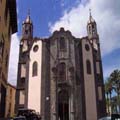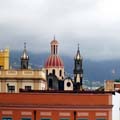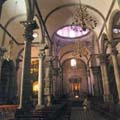History.
The aborigines named this precious and fertile land Arautapala or Araotava, which was part of the guanche menceyato of Taoro. As tradition has it, Bencomo, its famous chief, lived in two adjoining caves in the Pine Canyon (Barranco del Pino).
 The Adelantado Fernando de Lugo proceeded to hand out land properties once the conquest was over, saving a good area for himself.
The Adelantado Fernando de Lugo proceeded to hand out land properties once the conquest was over, saving a good area for himself.
Soon it had a mayor that depended upon La Laguna, in this way this villa was founded, growing around the Chapel of Thanksgiving (Acción de Gracias), that later on extended southwards, to the Villa de Arriba or neighbourhood of Farrobo. Among the buildings constructed were the temple of La Concepción, the convents of San Lorenzo, San Benito and San José as well as many civilian buildings.
In 1648 Felipe IV names it Villa Exenta, independent of La Laguna, with its own mayor. And in 1681 the church of San Juan del Farrobo is converted into a parochial church, segregating itself from La Concepción.
In the beginnings of this century, Alfonso XIII concedes, together with the approval of his shield, the title of Very Noble and Loyal Villa of La Orotava. (Muy Noble y Leal Villa de La Orotava).
Places of Historical Interest
Guildhall
Neoclassic style from the XIX century
Benítez de Lugo House
From the XVII century
Molina House
Dating from the year of 1590
 Monteverde House
Monteverde House
From the XVII century
Sculptor Fernando Estévez Birth House
From the XVIII century
Torre Hermosa House
From the XVII century
Orotava Casino
From the XVIII century
Temple of El Calvario
Neogothic style, dating back to the year of 1914. With images of La Piedad, San Isidro and Santa María de la Cabeza, as well as works of Fernando Estévez
Holy Trinity Hospital and Church of San Francisco
XIX and XX century
Church of San Agustín and Exconvent of Los Agustinos
XVII Century with a baroque classicist altarpiece.
Church of San Juan de Farrobo
 XVIII Century. Moresque Art In its altarpiece appears a Christ of El Calvario dating from the XVII century. Images from Fernando Estévez and Luján Pérez.
XVIII Century. Moresque Art In its altarpiece appears a Christ of El Calvario dating from the XVII century. Images from Fernando Estévez and Luján Pérez.
Church of Santo Domingo and Exconvent of San Benito de Abad
San Francisco Lavatories
XVII Century. Rehabilitated by the municipality’s School Workshop.